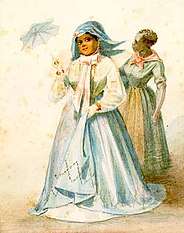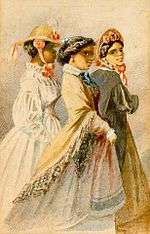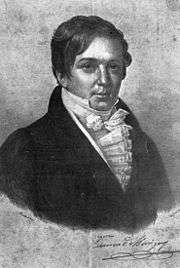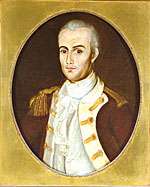Plaçage
Plaçage was a recognized extralegal system in French and Spanish slave colonies of North America (including the Caribbean) by which ethnic European men entered into civil unions with non-Europeans of African, Native American and mixed-race descent. The term comes from the French placer meaning "to place with". The women were not legally recognized as wives but were known as placées; their relationships were recognized among the free people of color as mariages de la main gauche or left-handed marriages. They became institutionalized with contracts or negotiations that settled property on the woman and her children and, in some cases, gave them freedom if they were enslaved. The system flourished throughout the French and Spanish colonial periods, reaching its zenith during the latter, between 1769 and 1803.
It was widely practiced in New Orleans, where planter society had created enough wealth to support the system. It also took place in the Latin-influenced cities of Natchez and Biloxi, Mississippi; Mobile, Alabama; St. Augustine and Pensacola, Florida;[1] as well as Saint-Domingue (now the Republic of Haiti). Plaçage became associated with New Orleans as part of its cosmopolitan society.
In recent years, at least three historians (viz. Kenneth Aslakson, Emily Clark, and Carol Schlueter) have challenged the historicity of plaçage and have referred to many of its features, including quadroon balls, as "a myth".[2][3]
History and development of the plaçage system
The plaçage system developed from the predominance of men among early colonial populations, who took women as consorts from Native Americans, free women of color and some enslaved Africans. In this period there was a shortage of European women, as the colonies were dominated in the early day by male explorers and colonists.
Given the harsh conditions in the colonies, persuading women to follow the men was not easy. France sent women convicted along with their debtor husbands, and in 1719, deported 209 women felons "who were of a character to be sent to the French settlement in Louisiana."[4]
The placage system first developed in Saint-Domingue. France sent women from the poor houses to the West Indies, but they had the reputation of also being former prostitutes from La Salpêtrière, and in 1713 and again in 1743, the authorities in Saint-Domingue complained that Paris sent the settlers unsuitable former prostitutes as wives.[5] The custom of sending brides from France was therefore discontinued in the French West Indies in the mid 18th-century, which benefitted the development of a placage system there. A new colonisation policy was adopted, in which male colonists from France merely came to the colony to make their fortune and returned to France after a few years, during which they did not marry but lived with a free woman of colour.[5]
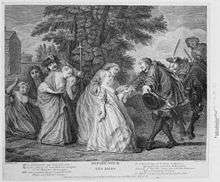
France also relocated young women orphans known as King's Daughters (French: filles du roi) to their colonies for marriage: to both Canada and Louisiana. France recruited willing farm- and city-dwelling women, known as casket or casquette girls, because they brought all their possessions to the colonies in a small trunk or casket.
Historian Joan Martin maintains that there is little documentation that "casket girls", considered among the ancestors of white French Creoles, were brought to Louisiana. The Ursuline order of nuns chaperoned the casket girls until they married. Martin writes that some Creole families who today identify as white had ancestors during the colonial period who were African or multiracial, and whose descendants married white over generations.[6]
Through warfare and raids, Native American women were often captured to be traded, sold, or taken as wives. At first, the colony generally imported African men to use as slave labor because of the heavy work of clearing to develop plantations. Over time, it also imported African women as slaves. Marriage between the races was forbidden according to the Code Noir of the eighteenth century, but interracial sex continued. The upper class European men during this period often did not marry until their late twenties or early thirties. Premarital sex with an intended white bride, especially if she was of high rank, was not permitted socially.
Free people of color
White male colonists, often the younger sons of noblemen, military men, and planters, who needed to accumulate some wealth before they could marry, had women of color as consorts before marriage or in some cases after their first wives died. Merchants and administrators also followed this practice if they were wealthy enough. When the women had children, they were sometimes emancipated along with their children. Both the woman and her children might assume the surnames of the man. When Creole men reached an age when they were expected to marry, some also kept their relationships with their placées, but this was less common. A wealthy white man could have two (or more) families: one legal, and the other not. Their mixed-race children became the nucleus of the class of free people of color or gens de couleur libres in Louisiana and Saint-Domingue. After the Haitian Revolution in the late 18th and early 19th centuries, many refugees came to New Orleans, adding a new wave of French-speaking free people of color.
During the period of French and Spanish rule, the gens de couleur came to constitute a third class in New Orleans and other former French cities - between the white Creoles and the mass of black slaves. They had certain status and rights, and often acquired education and property. Later their descendants became leaders in New Orleans, holding political office in the city and state, and becoming part of what developed as the African-American middle class in the United States.
By 1788, 1500 Creole women of color and black women were being maintained by white men.[7] Certain customs had evolved. It was common for a wealthy, married Creole to live primarily outside New Orleans on his plantation with his white family. He often kept a second address in the city to use for entertaining and socializing among the white elite. He had built or bought a house for his placée and their children. She and her children were part of the society of Creoles of color. The white world might not recognize the placée as a wife legally and socially, but she was recognized as such among the Creoles of color. Some of the women acquired slaves and plantations. Particularly during the Spanish colonial era, a woman might be listed as owning slaves; these were sometimes relatives whom she intended to free after earning enough money to buy their freedom.
While in New Orleans (or other cities), the man would cohabit with the placée as an official "boarder" at her Creole cottage or house. Many were located near Rampart Street in New Orleans—once the demarcation line or wall between the city and the frontier. Other popular neighborhoods for Creoles of color were the Faubourg Marigny and Tremé. If the man was not married, he might keep a separate residence, preferably next door or in the same or next block as his placée. He often took part in and arranged for the upbringing and education of their children. For a time both boys and girls were educated in France, as there were no schools in New Orleans for mixed-race children. As supporting such a plaçage arrangement(s) ran into thousands of dollars per year, it was limited to the wealthy.
Inheritance and work
Upon the death of her protector, the placée and her family could, on legal challenge, expect up to a third of the man's property. Some white lovers tried, and succeeded, in making their mixed-race children primary heirs over other white descendants or relatives. A notable inheritance case was the daughters of Nicolás María Vidal, a former high official in Spanish Louisiana, who with their mother, Eufrosina Hinard, successfully petitioned the U.S. government in the 1830s to intercede on their behalf to secure a portion of Vidal's estate.[8][9]
The women in these relationships often worked to develop assets: acquiring property, running a legitimate rooming-house, or a small business as a hairdresser, marchande (female street or country merchant/vendor), or a seamstress. She could also become a placée to another white Creole. She sometimes taught her daughters to become placées, by education and informal schooling in dress, comportment, and ways to behave. A mother negotiated with a young man for the dowry or property settlement, sometimes by contract, for her daughter if a white Creole were interested in her. A former placée could also marry or cohabit with a Creole man of color and have more children.
Contrary to popular misconceptions, placées were not and did not become prostitutes. Creole men of color objected to the practice as denigrating the virtue of Creole women of color, but some, as descendants of white males, benefited by the transfer of social capital. Martin writes, "They did not choose to live in concubinage; what they chose was to survive."
In the late 19th and early 20th centuries, after Reconstruction and with the reassertion of white supremacy across the former Confederacy, the white Creole historians, Charles Gayarré and Alcée Fortier, wrote histories that did not address plaçage in much detail. They suggested that little race mixing had occurred during the colonial period, and that the placées had seduced or led white Creole men astray. They wrote that the French Creoles (in the sense of having long been native to Louisiana) were ethnic Europeans who were threatened by the spectre of race-mixing like other Southern whites.
Gayarré, when younger, was said to have taken a woman of color as his placée and she had their children, to his later shame. He married a white woman late in life. His earlier experience inspired his novel Fernando de Lemos.
Notable placées
Marie Thérèse Metoyer
Marie Thérèse Metoyer dite Coincoin became an icon of black female entrepreneurship in colonial Louisiana. She was born at the frontier outpost of Natchitoches on Cane River in August 1742 as a slave of the post founder, the controversial explorer Louis Juchereau de St. Denis. She would be, for twenty years, the placée of a French colonial merchant-turned-planter, Claude Thomas Pierre Métoyer, who was two years her junior. At the onset of their plaçage, she was already the mother of five children; she would have ten more with Métoyer. In 1778, he freed her after the parish priest filed charges against Coincoin as a "public concubine" and threatened to have her sold at New Orleans if they did not end their relationship. As a free woman, she remained with Métoyer until 1788, when his growing fortune persuaded him to take a wife who could provide legal heirs. (He chose another Marie Thérèse, a white Créole of French and German birth.)
In setting Coincoin aside, Métoyer donated to her his interest in 80 arpents, about 68 acres (280,000 m2) of unpatented land, adjacent to his plantation, to help support their free-born offspring. On that modest tract, Coincoin planted tobacco, a valuable commodity in the struggling colony. She and her children trapped bears and wild turkeys for sales of meat, hide, and oil locally and at the New Orleans market. She also manufactured medicine, a skill shared by her formerly enslaved sister Marie Louise dite Mariotte and likely one acquired from their African-born parents. With this money, she progressively bought the freedom of four of her first five children and several grandchildren, before investing in three African-born slaves to provide the physical labor that became more difficult as she aged. After securing a colonial patent on her homestead in 1794, she petitioned for and was given a land concession from the Spanish crown. On that piney-woods tract of 800 arpents (667 ac) on Old Red River, about 5 mi from her farmstead, she set up a vacherie (a ranch) and engaged a Spaniard to tend her cattle. Shortly before her death in 1816, Coincoin sold her homestead and divided her remaining property (her piney-woods land, the three African slaves, and their offspring) among her own progeny.
As often happened among the children of plaçages, Coincoin's one surviving daughter by Métoyer, Marie Susanne, became a placée also. As a young woman, apparently with the blessing of both parents, she entered into a relationship with a newly arrived physician, Joseph Conant from New Orleans. When he left Cane River, soon after the birth of their son, she formed a second and lifelong plaçage with a Cane River planter, Jean Baptiste Anty. As a second-generation entrepreneur, Susanne became far more successful than her mother and died in 1838 leaving an estate of $61,600 (equivalent to $1,500,000 in 2009 currency).
Modern archaeological work at the site of Coincoin's farmstead is documenting some of the aspects of her domestic life. A mid-nineteenth century dwelling, now dubbed the Coincoin-Prudhomme House although it was not the actual site of her residence, commemorates her within the Cane River National Heritage Area. Popular lore also has, erroneously, credited her with the ownership of a Cane River plantation founded by her son Louis Metoyer, known today as Melrose Plantation, and its historic buildings Yucca House and African House. Her eldest half-French son, Nicolas Augustin Métoyer, founded St. Augustine Parish (Isle Brevelle) Church, the spiritual center of Cane River's large community of Creoles of color who trace their heritage to Coincoin.[10][11][12]
Eulalie de Mandéville
There were many other examples of white Creole fathers who reared and carefully and quietly placed their daughters of color with the sons of known friends or family members. This occurred with Eulalie de Mandéville, the elder half-sister of color to the eccentric nobleman, politician, and land developer Bernard Xavier de Marigny de Mandéville. Taken from her slave mother as a baby, and partly raised by a white grandmother, 22-year-old Eulalie was "placed" by her father, Count Pierre Enguerrand Philippe, Écuyer de Mandéville, Sieur de Marigny, with Eugène de Macarty, a member of the famous French-Irish clan in 1796. Their alliance resulted in five children and lasted almost fifty years.[4]
In contrast to the Macartys' stable relationship, Eugène's brother Augustin de Macarty was married and was said to have had numerous, complex affairs with Creole women of color. When he died, several women made claims on behalf of their children against his estate.[13]
On his deathbed in 1845, Eugène de Macarty married Eulalie. He willed her all of his money and property, then worth $12,000. His white relatives, including his niece, Marie Delphine de Macarty LaLaurie, contested the will. The court upheld his will. After Eulalie's death, their surviving children defeated another attempt by Macarty's relatives to claim his estate, by then worth more than $150,000. Eulalie de Mandéville de Macarty became a successful marchande and ran a dairy. She died in 1848.
Rosette Rochon
Rosette Rochon was born in 1767 in colonial Mobile, the daughter of Pierre Rochon, a shipbuilder from a Québécois family (family name was Rocheron in Québec), and his mulâtresse slave-consort Marianne, who bore him five other children. Once Rosette reached a suitable age, she became the consort of a Monsieur Hardy, with whom she relocated to the colony of Saint Domingue. During her sojourn there, Hardy must have died or relinquished his relationship with her; for in 1797 during the Haitian Revolution, she escaped to New Orleans, where she later became the placée of Joseph Forstal and Charles Populus, both wealthy white New Orleans Creoles.
Rochon came to speculate in real estate in the French Quarter; she eventually owned rental property, opened grocery stores, made loans, bought and sold mortgages, and owned and rented out (hired out) slaves. She also traveled extensively back and forth to Haiti, where her son by Hardy had become a government official in the new republic. Her social circle in New Orleans once included Marie Laveau, Jean Lafitte, and the free black contractors and real estate developers Jean-Louis Doliolle and his brother Joseph Doliolle.
In particular, Rochon became one of the earliest investors in the Faubourg Marigny, acquiring her first lot from Bernard de Marigny in 1806. Bernard de Marigny, the Creole speculator, refused to sell the lots he was subdividing from his family plantation to anyone who spoke English. While this turned out to be a losing financial decision, Marigny felt more comfortable with the French-speaking, Catholic free people of color (having relatives, lovers, and even children on this side of the color line). Consequently, much of Faubourg Marigny was built by free black artisans for free people of color or for French-speaking white Creoles. Rochon remained largely illiterate, dying in 1863 at the age of 96, leaving behind an estate valued at $100,000 (today, an estate worth a million dollars).
Marie Laveau
Marie Laveau (also spelled Leveau, Laveaux), known as the voodoo queen of New Orleans, was born between 1795 and 1801 as the daughter of a white Haitian plantation owner, Charles Leveaux, and his mixed black and Indian placée Marguerite Darcantel (or D'Arcantel). Because there were so many whites as well as free people of color in Haiti with the same names, Leveaux could also have been a free man of color who owned slaves and property as well. All three may have escaped Haiti along with thousands of other Creole whites and Creoles of color during the slave uprisings that culminated in the French colony's becoming the only independent black republic in the New World.
At 17, Marie married a Creole man of color popularly known as Jacques Paris (however, in some documents, he is known as Santiago Paris). Paris either died, disappeared or deliberately abandoned her (some accounts also relate that he was a merchant seaman or sailor in the navy) after she produced a daughter. Laveau was styling herself as the Widow Paris and was a hairdresser for white matrons (she was also reckoned to be an herbalist and yellow fever nurse) when she met Louis-Christophe Dumesnil de Glapion and in the early 1820s, they became lovers.
Marie was just beginning her spectacular career as a voodoo practitioner (she would not be declared a "queen" until about 1830), and Dumesnil de Glapion was a fiftyish white Creole veteran of the Battle of New Orleans with relatives on both sides of the color line. Recently, it has been alleged that Dumesnil de Glapion was so in love with Marie, he refused to live separately from his placée according to racial custom. In an unusual decision, Dumesnil de Glapion passed as a man of color in order to live with her under respectable circumstances—thus explaining the confusion many historians have had whether he was truly white or black.[14] Although it is popularly thought that Marie presented Dumesnil de Glapion with fifteen children, only five are listed in vital statistics and of these, two daughters—one the famous Marie Euchariste or Marie Leveau II—lived to adulthood. Marie Euchariste closely resembled her mother and startled many who thought that Marie Leveau had been resurrected by the black arts, or could be at two places at once, beliefs that the daughter did little to correct.
Sebastopol: This plantation house and property was built and cultivated by Don Pedro Morin in the 1830s in St. Bernard Parish, Louisiana. It was bought twenty years later by Colonel Ignatius Szymanski a Polish American who later served in the Confederate Army, and renamed Sebastopol. At his death, Colonel Szymanski willed this estate to his placée Eliza Romain, a free woman of color, and to their son John Szymanski.
Quadroon balls
The term quadroon is a fractional term referring to a person with one white and one mulatto parent, some courts would have considered one-fourth Black. The "quadroon balls" were social events designed to encourage mixed-race women to form liaisons with wealthy white men through a system of concubinage known as plaçage.[15]
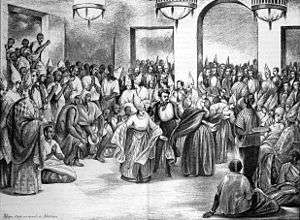
Quadroon Balls of Saint Domingue
The origin of quadroon balls can be traced to the redoutes des filles de couleur in Cap-Francais in the French colony of Saint Domingue.[16][17]
The French colony, where the male population outnumbered women, white women were few and there were few alternatives to prostitution for free women of color, was known in the Caribbean for its "Mulatto Courtesans", whose trademark was elegance, a haughty demeanor and the demand to be courted.[16] As there were no brothels in the colony, where sex workers worked independently, these balls were the place where the most exclusive courtesans met their clients; having met, they were set up as the official housekeeper (menagère) or openly kept as mistresses,[16] and when their male client died or left to settle in France for their retirement, they were normally left with money, property or slaves for their future support, a common background for free coloured businesswomen, [18] among whom the most famous were Nanette Pincemaille (d. 1784), Anne Laporte (d. 1783), Simone Brocard and Julie Dahey.
Many refugees from Saint-Domingue came to New Orleans and settled between the outbreak of the Haitian Revolution in 1791 until the Dominguan refuge colony in Cuba was ousted in 1809: both white, black and free people of color, who were used to the placage system in Saint Domingue, and who introduced a more formalized form of placage as well as the famous quadroon balls to New Orleans.[19]
Quadroon Balls of New Orleans
Monique Guillory writes about quadroon balls that took place in New Orleans, the city most strongly associated with these events. She approaches the balls in context of the history of a building the structure of which is now the Bourbon Orleans Hotel. Inside is the Orleans Ballroom, a legendary, if not entirely factual, location for the earliest quadroon balls.
In New Orleans in 1805, Albert Tessier, a refugee from Saint-Domingue,[19] began renting a dance hall where he threw twice weekly dances for free quadroon women and white men only.[20] This was an innovation in New Orleans at the time: balls for free women of colour had been held in New Orleans in the 1790s, but they had been opened for both white men and free men of colour, the latter of whom could marry the women rather than form a placage with them, and these new balls exclusively for free quadroon women and white men was therefore more closely associated with the placage system, introducing a Dominguan custom to New Orleans.[19]
The quadroon balls were elegant and elaborate, designed to appeal to wealthy white men. Although race mixing was prohibited by New Orleans law, it was common for white gentleman to attend the balls, sometimes stealing away from white balls to mingle with the city's quadroon female population. The principal desire of quadroon women attending these balls was to become placée as the mistress of a wealthy gentleman, usually a young white Creole or a visiting European.[21] These arrangements were a common occurrence, Guillory suggests, because the highly educated, socially refined quadroons were prohibited from marrying white men and were unlikely to find Black men of their own status.
A quadroon's mother usually negotiated with an admirer the compensation that would be received for having the woman as his mistress. Typical terms included some financial payment to the parent, financial and/or housing arrangements for the quadroon herself, and, many times, paternal recognition of any children the union produced. Guillory points out that some of these matches were as enduring and exclusive as marriages. A beloved quadroon mistress had the power to destabilize white marriages and families, something she was much resented for.
According to Guillory, the system of plaçage had a basis in the economics of mixed race. The plaçage of black women with white lovers, Guillory writes, could take place only because of the socially determined value of their light skin, the same light skin that commanded a higher price on the slave block, where light skinned girls fetched much higher prices than did prime field hands.[22] Guillory posits the quadroon balls as the best among severely limited options for these near-white women, a way for them to control their sexuality and decide the price of their own bodies. She contends:
- "The most a mulatto mother and a quadroon daughter could hope to attain in the rigid confines of the black/white world was some semblance of economic independence and social distinction from the slaves and other blacks".[23].
She notes that many participants in the balls were successful in actual businesses when they could no longer rely on an income from the plaçage system. She speculates they developed business acumen from the process of marketing their own bodies.
Treatment in fiction
- Isabel Allende, Island Beneath the Sea. A novel about a mixed-race slave who is brought to Saint-Domingue and is eventually taken to New Orleans with her master's family. Her quadroon daughter is introduced to society as a placée.
- George Washington Cable, The Grandissimes, A Story of Creole Life (1880) by . He also wrote the short stories "Títe Poulette", "Madame John's Legacy" and "Madame Delphine", which portrayed the placée as societal outcast.
- William Faulkner, Absalom, Absalom!. A young man is engaged to a woman until it is found out that he is already involved with a placée in New Orleans and has a child with her.
- Edna Ferber, Saratoga Trunk. The book was later adapted as a film by the same name, starring Ingrid Bergman and Gary Cooper. But it, like the film, falls apart after the action and the heroine move on to Saratoga Springs, New York.
- Barbara Hambly, The Benjamin January Mysteries. This series of novels features Benjamin January, a free man of color, in New Orleans in the 1830s. His mother and half-sister are also featured; both are placées. His wife is the daughter of a placée.
- Anne Rice, The Feast of All Saints. A coming of age novel about a young man making his way in Creole New Orleans. it was adapted as a film by the same name.
- Patricia Vaughn, Shadows on the Bayou. A historical romance following the life of Sylvia Dupont, a young woman raised to be a placée. Dupont marries a free man of color and struggles with the consequences.
- Sarah Riggs (screenplay), R.B. McGowen Jr. (story) Quadroon - 1971 film following preparation of prostitutes for presentation at the annual Quadroon Ball set in 1835 New Orleans.
- Marcus Gardley, The House That Will Not Stand premiered at Berkeley Repertory Theatre, January 31 – March 16, 2014.
- Beyoncé Knowles, in her "Formation" music video, features visuals of placées. This song was released February 6, 2016.
- Haunting of the Octoroon Mistress, a folktale featuring the institutions of octoroon balls and plaçage.
- The Courage to Love - a 2000 TV movie featuring Diahann Carroll as a placée and Vanessa Williams as her daughter struggling with the thought of also becoming a placée.
- The video game Assassin's Creed III: Liberation features a protagonist, Aveline de Grandpre, who is a free woman of color in 1760s New Orleans, the daughter of a French merchant and his placée.
See also
- Children of the plantation
- Concubinage
- Courtesan
- Hypergamy
- Inter-caste marriage
- Marriage à la façon du pays
- Morganatic marriage
- Signare
References
- Chained to the Rock of Adversity, To Be Free, Black & Female in the Old South, edited by Virginia Meacham Gould, University of Georgia Press, 1998
- "Mixed Race Studies » quadroon balls". www.mixedracestudies.org. Retrieved 22 October 2017.
- Melle, Stacy Parker Le (4 September 2013). "Quadroons for Beginners: Discussing the Suppressed and Sexualized History of Free Women of Color with Author Emily Clark". huffingtonpost.com. Retrieved 22 October 2017.
- Katy F. Morlas, "La Madame et la Mademoiselle," graduate thesis in history, Louisiana State University and Agricultural and Mechanical College, 2003
- Trevor Burnard, John Garrigus: The Plantation Machine: Atlantic Capitalism in French Saint-Domingue
- Joan M. Martin, Placage and the Louisiana Gens de Couleur Libre, in Creole, edited by Sybil Kein, Louisiana State University Press, Baton Rouge, 2000.
- Monique Guillory, "Under One Roof: The Sins and Sanctity of the New Orleans Quadroon Balls", in Race Consciousness, edited by Judith Jackson Fossett and Jeffrey A. Tucker, New York University Press, 1997.
- United States Congress (1834). "Transactions in the Floridas". American State Papers: Documents, Legislative and Executive, of the Congress of the United States. Washington, D.C.: Gales and Seaton.
- Clinton, Catherine; Gillespie, Michele (1997). The Devil's Lane: Sex and Race in the Early South. Oxford, England: Oxford University Press. pp. 238–239. ISBN 978-0-19-802721-8. Retrieved 17 October 2018.
- Mills, Elizabeth Shown. "Marie Thérèse Coincoin (1742–1816): Slave, Slave Owner, and Paradox", Chapter 1 in Janet Allred and Judy Gentry, ed., Louisiana Women: Their Lives and Times (Athens, Ga.: University of Georgia Press, 2009), chap. 1, pages 10-29
- Mills, Gary B. The Forgotten People: Cane River's Creoles of Color. Baton Rouge: Louisiana State University Press, 1977.
- Mills, Elizabeth Shown. "Which Marie Louise is 'Mariotte'? Sorting Slaves with Common Names." National Genealogical Society Quarterly 94 (September 2006): 183–204; archived online at Historic Pathways.
- Violet Harrington Bryan, "Marcus Christian's Treatment of Les Gens de Couleur Libre", in Creole, edited by Sybil Kein, Louisiana State University Press, Baton Rouge, 2000.
- Caryn Cosse Bell, "The Real Marie Laveau", review of Voodoo Queen: The Spirited Lives of Marie Laveau, by Martha Ward, University Press of Mississippi, Jackson, 2004.
- Monique Guillory, "Under One Roof: The Sins and Sanctity of the New Orleans Quadroon Balls", 68-9
- Jorge Canizares-Esguerra, Matt D. Childs, James Sidbury: The Black Urban Atlantic in the Age of the Slave Trade
- Trevor Burnard, John Garrigus: The Plantation Machine: Atlantic Capitalism in French Saint-Domingue
- Stewart R. King: Blue Coat Or Powdered Wig: Free People of Color in Pre-revolutionary Saint Domingue
- Emily Clark:The Strange History of the American Quadroon
- Monique Guillory, "Under One Roof: The Sins and Sanctity of the New Orleans Quadroon Balls", 80
- Monique Guillory, "Under One Roof: The Sins and Sanctity of the New Orleans Quadroon Balls", 81
- Monique Guillory, "Under One Roof: The Sins and Sanctity of the New Orleans Quadroon Balls", 82
- Monique Guillory, "Under One Roof: The Sins and Sanctity of the New Orleans Quadroon Balls", 83
Further reading
Recent books
- The Free People of Color of New Orleans, An Introduction, by Mary Gehman and Lloyd Dennis, Margaret Media, Inc., 1994.
- Africans in Colonial Louisiana: The Development of Afro-Creole Culture in the Eighteenth Century, by Gwendolyn Midlo Hall, Louisiana State University Press, 1995.
- Creole New Orleans, Race and Americanization, by Arnold R. Hirsch and Joseph Logsdon, Louisiana State University Press, 1992.
- Bounded Lives, Bounded Places: Free Black Society in Colonial New Orleans, by Kimberly S. Hanger.
- Afristocracy: Free Women of Color and the Politics of Race, Class, and Culture, by Angela Johnson-Fisher, Verlag, 2008.
- The Strange History of the American Quadroon − Free Women of Color in the Revolutionary Atlantic World, by Emily Clark, The University of North Carolina Press, 2013.
Contemporary accounts
- Travels by His Highness Duke Bernhard of Saxe-Weimar-Eisenach through North America in the years 1825 and 1826, by Bernhard, Duke of Saxe-Weimar-Eisenach; William Jeronimus and C.J. Jeronimus, University Press of America, 2001. (The Duke relates his visits to quadroon balls as a tourist in New Orleans.)
- Voyage to Louisiana, (An abridged translation from the original French by Stuart O. Landry) by C.C. Robin, Pelican Publishing Co., 1966. (Robin visited Louisiana just after its purchase by the Americans and resided there for two years.)
External links
- Mon Cher at the Wayback Machine (archived June 29, 2006), Creole genealogical newsletter, dated June 20, 2003, on the genealogy of Marie Laveau, also related to the Trudeaus, page 5.
- "Up Through Slavery", Information about the life of Marie Thérèse Coincoin Metoyer.
- "French Quarter Square Number 912" at the Wayback Machine (archived December 6, 2000), History of 918 Barracks Street in the French Quarter, where Eugène Macarty purchased and then built another home for his placée, Eulalie Mandeville (fwc; for free woman of color) and their children.
- Louisiana Creoles of Color
- Musée Rosette Rochon at the Wayback Machine (archived December 5, 2004), located on 1515 Pauger Street, Marigny, New Orleans. This house, which survived Hurricane Katrina, is the only extant residence built by Mme. Rochon.
